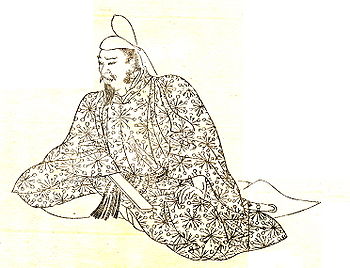- Ono no Takamura
-
 Ono no Takamura, in a book illustration by Kikuchi Yōsai.
Ono no Takamura, in a book illustration by Kikuchi Yōsai. In this Japanese name, the family name is "Ono".
In this Japanese name, the family name is "Ono".Ono no Takamura (小野 篁) also known as Sangi no Takamura (参議篁 sangi no takamura, 802–February 3, 853) was an early Heian period scholar and poet.
Contents
Life
Takamura is a descendant of Ono no Imoko who served as Kenzuishi, and his father was Ono no Minemori. He is the grandfather of Ono no Michikaze, one of the three famous calligraphers (三筆 sanpitsu). In 834 he was appointed to Kintōshi, but in 838 after a quarrel with the envoy, Fujiwara no Tsunetsugu, he gave up his professional duties pretending to be ill, and attracted the ire of retired Emperor Saga, who sent him to Oki Province. Within two years he regained the graces of the court and returned to the capital where he was promoted to Sangi.
Takamura is the subject of a number of odd stories and legends. One of the most singular of these legends is the claim that every night he would climb down a well to hell and help Yama (閻魔大王 enma daiō) in his judgements (裁判 saiban). In Sataku, Kyoto, there is a grave said to belong to Takamura. Near that grave is a grave marked Murasaki Shikibu, with a legend that it was placed there by the devil himself as punishment for lust (愛欲 aiyoku) for which Murasaki Shikibu descended to hell.
In Ujishūi Monogatari there is the following story about Takamura to illustrate his wit. One day in the palace of Saga Tennō, someone erected a scroll with the writing "無善悪". No one in the palace was able to decipher its meaning. The emperor then ordered Takamura to read it, and he responded "Without evil there is no goodness (悪無くば善からん saga nakuba yokaran)," reading the character for evil (悪 aku) as "Saga" to indicate Saga Tennō. The emperor was incensed at his audacity and proclaimed that because only Takamura was able to read the scroll, he must have been the one who put it up in the first place. Takamura however pleaded his innocence, saying that he was simply deciphering the meaning of the scroll. The emperor said, "Oh, so you can decipher any writing, can you?" and asked Takamura to read a row of twelve characters for child (子): "子子子子子子子子子子子子". Takamura immediately responded: neko no ko no koneko, shishi no ko no kojishi (猫の子の子猫、獅子の子の子獅子), using the variant readings ne, ko and shi/ji for the character; this translates to "the young of cat (猫 neko), kitten (子猫 koneko), and the young of lion (獅子 shishi), cub (子獅子 kojishi)." The emperor was amused by Takamura's wit and removed the accusation.
Takamura is the main character in the tale Takamura Monogatari.
Descendants
While people like Ono no Michikaze and Ono no Komachi are Takamura's direct descendants, he also had several spiritual descendants among the Samurai. In particular, several Samurai names such as Notarō (野太郎), Onota (小野太), Yatarō (弥太郎), Koyata (小弥太) can be traced to Takamura.
Representative poems
One of his poems is included in the Ogura Hyakunin Isshu.
わたの原 八十島かけて 漕ぎいでぬと
人にはつげよ あまのつり舟
(Ogura Hyakunin Isshu, 11)Takamura contributes six poems to the Kokin Wakashū: #335, 407, 829, 845, 936, and 961.
泣く涙 雨と降らなむ わたり川
水まさりなば かへりくるがに
(Kokin Wakashū, #829)- Tatsumiya. Tales from the Realm of the Dead: Takamura's Well (冥界伝説:たかむらの井戸 meikai densetsu: takamura no ido).
- Yūko Satsuma. Fudaya Ichiren! (札屋一蓮!).
- Yū Itō (1997). Devil's Bridge (鬼の橋 oni no hashi). ISBN 4-8340-1571-8.
See also
References
- This article is based on material from the equivalent article from the Japanese Wikipedia.
Categories:- 802 births
- 853 deaths
- Japanese writers
- Classical Japan
- Japanese writer stubs
Wikimedia Foundation. 2010.
